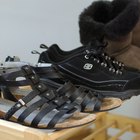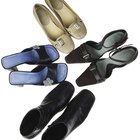Though humans have worn shoes for centuries, standard shoe sizes were not established until the 1300s. Today's shoe manufacturers derive their shoe sizes using those original methods, though the process has been tweaked over time to accommodate retail trends and man's ever-growing shoe size. Here is a look at how shoe sizes are calculated, as well as the difference between genders, children, and countries.
History
The barleycorn, which had been used as a measuring standard for centuries, was first established in Britain as a means to measure shoe size in the 14th century. Measuring a third of an inch, King Edward II's foot was 36 barleycorns long, 12 inches, and thus a size 12. From that standard, sizes increased or decreased in one-barleycorn increments. For example, a size 11 was 35 barleycorns long, or 11 2/3 inches. Over the years different regions have adopted different standards for men, women, and children sizes.
UK
The lowest British shoe size is a child's zero and increases incrementally from there. Full-sizes increase by a third of an inch, and half-sizes increase by a sixth of an inch. Children shoe sizes continue up to size 13.5 before becoming an adult size one. A child's shoe size can be estimated by multiplying the length of the foot by three, then subtracting 12 from the result. An adult size can be estimated by multiplying the length of the foot by three, then subtracting 25. There is no difference between men and women shoe sizes. As far as uncommon widths, narrow sizes are marked with an E and wide sizes are marked with a G or an H, though these markings are not necessarily standardized and may vary between manufacturers.
North America
The United States' standard, usually shared by Canada, is slightly more complex. In the States adult sizes begin at one, then continue in the same manner as the British system. Men shoe sizes are therefore labeled one higher than a UK shoe of equal length. Women sizes, however, are labeled 1.5 higher than US men sizes. Child sizes begin at 5, run to size 13.5, then start over at size one. As a result, a child's size 4 is much larger than a child's size 5. Despite this they increase in the standard third-of-an-inch increments. There is no difference between boy and girl sizes. Narrow shoes are marked with an A, B, or C, and wide shoes are marked with an E.
Australia
In Australia shoe sizes follow the same barleycorn system but with slight differences. Men sizes in Australia and New Zealand are generally the same as the men sizes in the UK. Women sizes are a size higher than women sizes in the UK. Child sizes are equivalent to child sizes in the UK.
Continental Europe
Shoe sizes in continental Europe are measured using Paris points, which are increments of two-thirds of a centimeter. A shoe size in Europe is the number of Paris points in two centimeters plus the size of the foot. A foot 26 centimeters long would be a size 42. Both adult men and women as well as children follow this system.
Asia
In Japan, men shoe sizes are generally labeled 18 sizes larger than North American shoe sizes for men. Women shoes in Japan are labeled 16 sizes larger than women shoes in North America. Shoes in Korea are measured in millimeters and usually increase in five millimeter increments. Chinese shoe sizes are based on centimeters, but there is conflicting information regarding comparable UK and US sizes.
Warning
Due to differing measuring standards between shoe manufacturers, shoe material, and shoe shapes, as well as differing industrial standards in different countries, shoe sizes will vary between brands and regions. Shoe charts should be regarded as helpful guides rather than unwavering fact. The only sure way to determine if a particular size fits is to try it on.
Related Articles

How to Compare Men's Shoe Size to Boys' ...

What Does Shoe Width E, EE, D, and DD ...

Korean vs. American Clothing Sizes for ...

What Does Big Kids Mean in Shoe Sizing?

How to Measure Shoe Width Size

Is a Kids' Size Six Shoe the Same as a ...

Difference Between Women's Wide & EEE ...

Wide Width Vs. Double Wide Width Shoes

What Is the Difference Between a Narrow ...

What Does E Mean in Boot Size?

How to Convert Women's Shoe Sizes to ...

How to Convert a Shoe's Size to ...

Medium D Vs. Wide EE Shoe Size

How to Tell the Size of Havaianas

How to Size Boys' Clothes

Difference Between Metric & American ...

How to Size Children's Socks

Difference Between Percent Alcohol & ...

What is the Typical American Family?

What Is the Average Breast Measurement?
References
Writer Bio
Maintaining his United States citizenship, Mickey Scott is a Canadian resident recently transplanted from the American Midwest. He holds a broadcasting degree from Central Missouri State University with a minor in creative writing. In addition to Demand Studios, Scott also contributes to Suite 101.